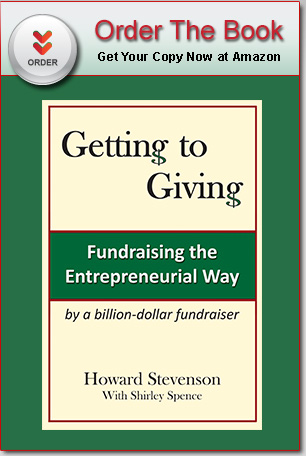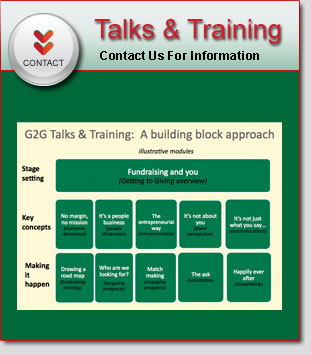


I almost never do that, for two reasons. First, I don’t like it when people do that to me, especially early on. Second, as a fundraiser, you don’t know the donor’s situation. Read More
There typically are three drivers of corporate giving: the CEO, HR and/or Marketing. Sometimes, it’s essentially individual giving; the CEO decides how much and who to give to. That is often critiqued by employees and snubbed gift recipients. As a fundraiser, getting access to and understanding the giving priorities of the CEO are the keys. Read More
To start, “no margin, no mission” applies to every organization. In fact, it was a nun in charge of a church-run hospital who introduced me to that truth. What is your economic model? Then, what do you stand for, why is it important, and who might be interested? Finally, don’t forget the bricks and mortar. Read More
Through my own board work, requests for advice from friends and colleagues, and the G2G community, I get to see a wide range of organizations. These are challenging times for most everyone, I must say. Here is my take on the top five issues facing fundraising leadership today. Read More
At one level, the answer is Management 101. Leadership needs to pay attention to its economic model and cost structure. At another level, it’s a systemic problem. The sheer number of nonprofits – many quite small – breeds inefficiencies. Overhead is duplicated, and services overlap. Read More
I am a strong believer in raising children to feel a sense of responsibility to the community. That’s how I was raised, and that’s an attitude and behavior that I have tried to model for my children. It can start early, in small ways. Read More
I will be doing some private fundraising for a tax supported charter school in a low income area. Do you have any suggestions as to our best approach to potential donors including foundations? The primary objective is to build a new neighborhood school, for which about $3M in private funds will be required.
I should start by saying that I don’t think foundations are a good target. Many don’t like capital projects because they don’t directly serve a nonprofit’s purpose. Read More
You may (or may not!) be referring to the hype around Nike co-founder Phil Knight’s $500 million challenge gift to Oregon Health & Science University. Some people seem to see it as a positive thing; it will boost philanthropy as a whole and attract new donors to a variety of causes, they say. But, others are worried. Personally, I think that fear of major donor poaching to be a little suspect, even whiny. How committed are they, if they’ll jump ship at the drop of a hat (or a few bucks)? How engaged are they in your work in general, and the work that their dollars are funding in particular? Are you communicating (remember – show and tell) the impact that your organization and their funds are having? Do they have concerns about management, or feel less than satisfied with their experience? The onus is on you to build and sustain the relationship. Read More
Crowdfunding basically involves collecting money from backers – the “crowd” – for a for- profit or nonprofit initiative, usually on an Internet platform.
There’s no denying that crowdfunding is hot. There are a variety of flavor of crowdfunding out there, and a lot of hype. In the nonprofit world, crowdfunding is more useful for a participative fundraising strategy (i.e., getting a lot of people to give a little something) than significant gift fundraising, I believe. I also must state the obvious: It ain’t free. As with any approach, you have to weigh the costs and the benefits. Read More
Faster isn’t always better, especially when it comes to soliciting major gifts. But, by sharpening your focus, you can improve your results and make your donors happier. Read More